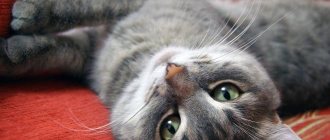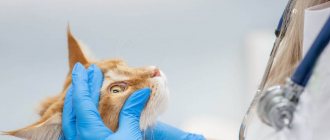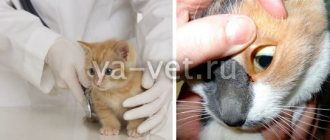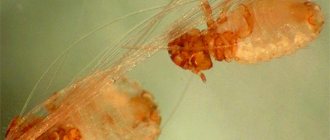Thromboembolism in cats is a syndrome of acute disturbance of blood flow in a pet, caused by the process of embolization (blockage) of an artery by a blood clot (thrombus). According to experts, this disease accompanies extensive trauma in the animal, cardiomyopathy, as well as chronic heart and kidney failure. The localization of the blood clot usually occurs in the place where the aorta is divided into two branches (bifurcation area). However, blockages can also develop in the arteries of the kidneys or lungs.
This pathology is dangerous because the thrombus, as it moves through the blood vessels, can completely block the vessel of the limb. This leads to paresis or paralysis of the pet’s hind legs and the onset of necrotic processes in the blocked parts of the body. The article will discuss in detail the causes of thrombosis, the main symptoms and treatment methods.
general characteristics
The owner must clearly understand that the disease in question is a concomitant rather than an independent disease. That is, it develops against the background of various diseases, mainly heart ones, that the cat had or still has.
A blood clot often develops in the left atrium, through which it can travel to the most distant parts of the aorta. As a result, a meowing friend may develop problems in the gastrointestinal tract, brain, kidneys, and also completely lose their hind or forelimbs.
Veterinarians note that thromboembolism can be arterial and venous. They differ in the location of the blood clot. Moreover, blood clots are even more common in veins. This occurs due to the speed of blood flow: in the artery it is very fast, and in the vein it is slow. In addition, arterial vessels have a smooth intima (inner lining), which prevents the formation of clots. On the other hand, a blood clot formed in a vein practically cannot lead a pet to instant death. But the one that arose in the aorta is fine.
Literature
- Cote E, MacDonald KA, Meurs KM, Sleeper MM. Feline cardiology. Iowa: Wiley-Blackwell; 2011.
- Smith SA, Tobias AH. Feline arterial thromboembolism: An update. Vet Clin North Am Small Anim Pract 2004;34:1245–1271.
- Flanders JA. Feline aortic thromboembolism. Comp Cont Educ Pract 1986;8:473–480.
- Smith SA, Tobias AH, Jacob KA, et al. Arterial thromboembolism in cats: Acute crisis in 127 cases (1992‐2001) and long‐term management with low‐dose aspirin in 24 cases. J Vet Intern Med 2003;17:73–83. ]
- Buchanan JW, Baker GJ, Hill JD. Aortic embolism in cats: Prevalence, surgical treatment and electrocardiography. Vet Rec 1966;79:496–505.
- Laste NJ, Harpster NK. A retrospective study of 100 cases of feline distal aortic thromboembolism: 1977‐1993. J Am Anim Hosp Assoc 1995;31:492–500.
- Schoeman JP. Feline distal aortic thromboembolism: A review of 44 cases (1990‐1998). J Feline Med Surg 1999;1:221–231.
- Moore KE, Morris N, Dhupa N, et al. Retrospective study of streptokinase administration in 46 cats with arterial thromboembolism. J Vet Emerg Crit Care 2000;10:13.
- Rush JE, Freeman LM, Fenollosa NK, Brown DJ. Population and survival characteristics of cats with hypertrophic cardiomyopathy: 260 cases (1990‐1999). J Am Vet Med Assoc 2002;220:202–207.
- Payne J, Luis Fuentes V, Boswood A, et al. Population characteristics and survival in 127 referred cats with hypertrophic cardiomyopathy (1997 to 2005). J Small Anim Pract 2010;51:540–547.
- Atkins CE, Gallo AM, Kurzman ID, Cowen P. Risk‐factors, clinical signs, and survival in cats with a clinical‐diagnosis of idiopathic hypertrophic cardiomyopathy - 74 cases (1985‐1989). J Am Vet Med Assoc1992;201:613–618.
- Baty CJ, Malarkey DE, Atkins CE, et al. Natural history of hypertrophic cardiomyopathy and aortic thromboembolism in a family of domestic shorthair cats. J Vet Intern Med 2001;15:595–599.
- Smith CE, Rozanski EA, Freeman LM, et al. Use of low molecular weight heparin in cats: 57 cases (1999‐2003). J Am Vet Med Assoc 2004;225:1237–1241.
- Welch KM, Rozanski EA, Freeman LM, Rush JE. Prospective evaluation of tissue plasminogen activator in 11 cats with arterial thromboembolism. J Feline Med Surg 2010;12:122–128.
- Ferasin L, Sturgess CP, Cannon MJ, et al. Feline idiopathic cardiomyopathy: A retrospective study of 106 cats (1994‐2001). J Feline Med Surg 2003;5:151–159.
- Fox PR, Liu SK, Maron BJ. Echocardiographic assessment of spontaneously occurring feline hypertrophic cardiomyopathy. An animal model of human disease. Circulation 1995;92:2645–2651.
^Top
Causes
Blood clots can form in blood vessels due to the following factors:
- infection and sepsis;
- poisoning of an animal with toxic substances;
- pathologies of the cardiovascular system;
- oncological diseases;
- the presence of enzymes in the blood;
- mechanical damage to blood vessels;
- previous operations.
It is important for cat owners to know that, according to statistics, these animals more often than others suffer from diseases of the cardiovascular system. Therefore, the formation of clots in arteries and veins is not uncommon for them.
What are the prospects for pulmonary embolism?
This depends on the type of pulmonary embolism and the presence of concomitant diseases.
If PE is treated correctly and promptly, the prognosis is good and most patients can make a full recovery.
The prognosis is worse if there is a serious disease that contributed to the embolism, such as advanced cancer. Massive PE is more difficult to treat and is life-threatening. PE is a serious condition and can have a high risk of death, but this is greatly reduced with early treatment.
The most dangerous time for complications or death is the first few hours after an embolism. In addition, there is a high risk of developing a new pulmonary embolism within six weeks of the first one. Therefore, treatment must be started immediately and continued for at least six months.
Symptoms of the disease
Experts are convinced that in many respects the signs of the disease are determined by the location of the process. The most striking symptoms of thromboembolism in cats are expressed as follows:
- The cat's coordination of movements is impaired and lameness appears.
- Palpation of the hind legs may reveal paralysis of both legs. At the same time, the muscles on them become like stone.
- The tailed fidget's paw pads are turning pale.
- If a blood clot has blocked the renal arteries, the animal will begin to suffer from pain in the lumbar region and severe vomiting will occur. A blood test may show an increased content of nitrogenous metabolic products.
- Thromboembolism of the mesenteric arteries is characterized by the fact that the pet begins to have diarrhea and vomiting, often with the presence of blood in the discharge. Palpation of the abdomen leads to painful reactions.
- Coma, seizures reminiscent of epileptic and disturbances in the functioning of the vestibular apparatus are signs of a blood clot that is located in the blood vessels of the brain.
- If a blood clot forms in the pulmonary artery, the pet will develop a severe cough and shortness of breath. The mucous membranes turn pale. The pulse becomes weak, and the jugular veins characteristically swell.
Data from statistical studies regarding the survival rate of pets who have developed thromboembolism are extremely disappointing. The presence of a blood clot is aggravated by the entry of ischemic toxins into the blood. Taken together, this leads to multiple development of pathological processes in the animal’s body.
Thromboembolism in cats can only be cured if detected early. A timely diagnosis by a qualified specialist and immediate treatment can minimize the damage caused by a blood clot traveling through the cat’s bloodstream. Otherwise, the risk of death increases with each lost day.
How to prevent pulmonary embolism?
To avoid pulmonary embolism, it is necessary to prevent and promptly treat chronic diseases. One of the causes of venous thrombosis is varicose veins. Any person who suspects he has this disease should visit a phlebologist and have the venous system of the lower extremities diagnosed. After diagnosis, you need to follow the doctor's recommendations. Also, patients planning major surgery should be assessed for the risk of deep vein thrombosis, and people at high risk of DVT may require prophylactic doses of anticoagulants before and after surgery.
Diagnostic methods
With pronounced clinical symptoms, identifying thromboembolism is not particularly difficult for a doctor. If the signs are not so characteristic, then a number of procedures will help determine an accurate diagnosis. These include:
- Biochemical analysis of the animal’s blood, as well as an additional study of its clotting time.
- Ultrasound of the heart is aimed at assessing the speed at which myocardial contractions occur, as well as how much the atria have increased or decreased compared to normal.
- Angiography is a procedure through which it is possible to identify pathologies in the functioning of an animal’s blood vessels.
Cost of services
EXCLUDING MEDICINES AND CONSUMABLES NIGHT RATE for services from 23-00 to 8-00 + 100%
| № | Name of veterinary services | units measurements | Price in rubles | |
| RECEPTION AND CONSULTATION OF SPECIALISTS | ||||
| 1 | Initial appointment with a therapist | 1 appointment | 800-00 | |
| 2 | Initial appointment with a surgeon | 1 appointment | 800-00 | |
| 3 | Initial appointment with a specialist, candidate of veterinary sciences | 1 appointment | 1200-00 | |
| 4 | Repeated clinical examination | 1 appointment | 400-00 | |
| 5 | Repeated appointment with a specialist | 1 appointment | 600-00 | |
| 6 | Consultation without an animal (up to 15 minutes), or consultation on tests (from other laboratories) | 1 consultation | 400-00 | |
| 7 | Consultation without an animal (more than 15 minutes), or consultation by appointment from another clinic | 1 consultation | 500-00 | |
| 8 | Calling a doctor at home: — in the Krylatskoye district — in Moscow — according to Moscow Region | 1 call | 1000-00 1500-00 2500-5000 | |
| DIAGNOSTICS | ||||
| 9 | Weighing the animal | 1 animal | 0-00 | |
| 10 | Taking blood samples for tests | 1 manipulation | 400-00 | |
| 11 | Ultrasonography — overview - repeated | 1 study | 1500-00 1000-00 | |
| 12 | Ultrasonography - separate system - repeated | 1 study | 1000-00 800-00 | |
| 13 | 3D ultrasound examination | 1 study | 1600-00 | |
| 14 | Echokg/ repeated | 1 study | 1500-00/ 1000-00 | |
| 15 | Radiography 1 projection | 1 photo | 1200-00 | |
| 16 | X-ray 2 projections | 1 photo | 2000-00 | |
10 years of impeccable work
3 candidates of veterinary sciences on staff
Our specialists performed 3000+ operations
24/7 assistance 24/7
MAKE AN APPOINTMENT
Treatment of the disease
How effective the treatment of thromboembolism in cats will be directly depends on how quickly the owners contact the veterinary hospital. If the process has not gone too far, the doctor will definitely try to restore normal blood flow in the animal. The most drastic, but also effective methods include surgery. In this case, the veterinarian opens the aorta in order to free the duct and prevent the occurrence of ischemia.
It is important to understand that this disease itself is only a symptom. Therefore, a specialist needs to eliminate the cause of its appearance, that is, a blood clot. After a blood clot is found, infusion therapy is performed, allowing the blood to remain in the vascular bed. The last step will be to prescribe thrombolytics to your pet - drugs that prevent the formation of blood clots. The dose and intensity of medication is prescribed by a specialist depending on the individual characteristics of the patient.
The owner should be aware that the risk of death during surgery is very high. As an alternative, rheolytic thrombectomy can be used. Its essence lies in the fact that the doctor tries to “break” the clot using a catheter inserted into the vessel. The cat is under general anesthesia at this time. The procedure is very complex, and only an experienced veterinarian can perform it efficiently. But even this does not provide a complete guarantee of recovery; a relapse can occur within 3-4 weeks.
In particularly advanced cases of thromboembolism, when the pet’s body has already undergone the process of tissue necrosis, the best solution would be to stop the pet’s suffering and euthanize it.
Who develops pulmonary embolism?
Almost all cases of pulmonary embolism are caused by deep vein thrombosis. Thus, people who are more likely to get pulmonary embolism are people who are prone to deep vein thrombosis. Let's look at some risk factors for pulmonary embolism. Important factors are immobility, severe somatic pathologies and major surgical intervention (especially gynecological operations, operations on the pelvis and lower extremities). The risk of developing deep vein thrombosis or PE in hospital can be significantly reduced by activating the patient to walk as soon as possible. Medicines to help prevent deep vein thrombosis and PE are also prescribed to those patients who are at high risk.
Preventive actions
As a result of research, veterinarians have found that the average life expectancy of a cat that has undergone surgery to remove a blood clot ranges from 3 months to 2 years. Very rarely, but it happens that the pet returns to its normal life. True, this is the exception rather than the rule. Much more often, a furry friend remains disabled forever, having difficulty moving and meeting his natural needs. Therefore, it is better to prevent the disease than to risk your pet’s health later.
There are no special preventive measures that will effectively protect a cat from blood clots. However, the owner should try to protect the animal from excessively fatty foods. Cats whose diet consists of healthy foods rich in vitamins and microelements get sick much less often. In addition, your cat should be vaccinated on time and given anthelmintic drugs. Such measures will reduce the risk of blood clots developing in the animal’s vessels by a quarter.
Prevention
According to the results of studies conducted by veterinarians, the life expectancy of cats diagnosed with thromboembolism is on average 3 months. up to 1.5-2 years. There is very little chance that a sick pet will be able to return to a full life. Often, the animal remains deeply disabled until the end of its days, unable to move normally and independently cope with its natural needs.
There are no specific prevention methods that can prevent this dangerous disease. If one of the kitten’s parents has been diagnosed with thromboembolism, it is important for the owner to monitor the pet’s nutrition from childhood, monitor the completeness and balance of the food, and prevent the cat from overeating in order to prevent obesity. In addition, it is important to prevent injury to the animal and prevent poisoning by chemicals.
Frequently asked patient questions about pulmonary embolism (PE)
What are the symptoms of pulmonary embolism?
The main symptoms to suspect pulmonary embolism are cough, shortness of breath, chest pain and hemoptysis.
How to avoid pulmonary embolism?
In order to prevent the development of pulmonary embolism, it is necessary to prevent venous thrombosis: promptly treat varicose veins and other vein pathologies, avoid prolonged immobilization for various diseases and surgical treatment, use anticoagulants in case of increased risks of thrombosis.
Who is more likely to develop pulmonary embolism?
Pulmonary embolism, as a rule, affects patients with severe cardiac and pulmonary pathology, cancer patients, and patients in various surgical hospitals after long-term surgical interventions.
What should you do if you suspect pulmonary embolism?
At the slightest suspicion of pulmonary embolism, you must call an ambulance. Before the arrival of medical personnel, the patient must be laid on a flat surface and ensure free access of air.











